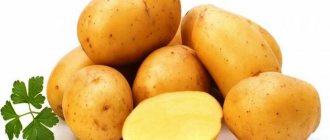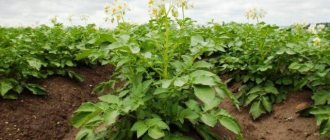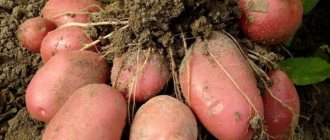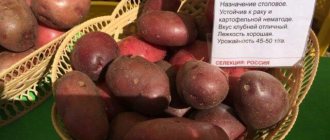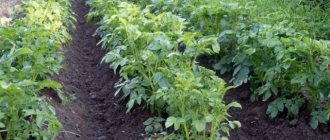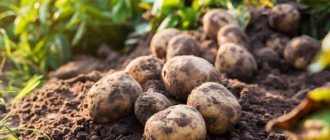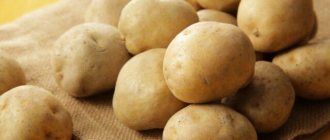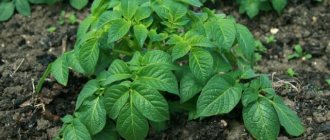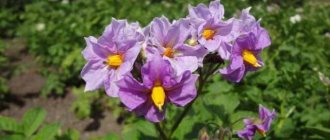Dutch potatoes are not the name of a separate variety. Popular varieties bred by Dutch specialists, such as Scarlett, Gala, Riviera, Latona, etc., are combined under this name. Such confusion occurred due to the fact that in the 80s. During perestroika, many foreign varieties of vegetable crops were imported. In particular, Dutch potato varieties appeared in the USSR. Soviet and then Russian gardeners did not particularly divide the imported seed potatoes by variety, uniting them under one name - Dutch. Subsequently, the popular abbreviation “Dutch” appeared. A similar process occurred with American varieties.
The popularity of Dutch varieties of this vegetable crop is explained by their high yield and good tolerance to the varied and difficult climatic conditions of Russia.
Description of popular Dutch varieties
Dutch potato varieties have deservedly become leaders all over the world, as they are one of the highest-yielding and adaptive potato varieties. Potato varieties of Dutch selection, first of all, were bred specifically for the cold climate of the northern regions, which is why they have taken root in Russia.
Characteristics of the best Dutch varietal potatoes
| Name | Description | Peculiarities |
| Impala | Productivity – 360 c/ha; | Mid-early; |
| Tuber weight – up to 150 g; | During transportation, the integrity of the fruit is not compromised; | |
| The number of fruits on a branch is up to 20 pieces; | Shows its best qualities in the North-Western, Central and Volga-Vyatka regions | |
| Maturation period – 2 months; | ||
| The color of the pulp is intense yellow; | ||
| Oval shape; | ||
| Starch content – on average 12%; | ||
| Keeping quality – 100% | ||
| Condor | Productivity – 350 c/ha; | Mid-early, table; |
| Fruit weight – 140 g; | Drought-resistant, adapts well to climatic conditions; | |
| The number of fruits on a branch is 6-11 pieces; | Recommended for the Central, Central Black Earth, Volgovyat and Lower Volga regions | |
| Maturation period – 3 months; | ||
| The color of the pulp is milky; | ||
| Oval shape; | ||
| Starch content – 9-14%; | ||
| Keeping quality – 94% | ||
| Latona | Productivity – 460 c/ha; | Early; |
| Average weight – 110 g; | Adapts to both dry weather and conditions of excess humidity; | |
| Fruits on a branch - 10-15 pieces; | Recommended for regions with temperate climates | |
| The ripening period is 1.5-2 months; | ||
| The color of the pulp is light yellow; | ||
| The shape is round, slightly elongated; | ||
| Starch content – 16-20%; | ||
| Keeping quality – 90% | ||
| Red Scarlett | Productivity – 400 c/ha; | Early, table; |
| The weight of the fetus reaches 150 g; | Perfectly stored and transportable; | |
| The number of fruits on a branch is up to 15 pieces; | Preferred for planting in the Central and Southern regions | |
| The ripening period is 1.5-2.5 months; | ||
| The color of the pulp is rich yellow; | ||
| Oval shape; | ||
| Starch content – 10-15%; | ||
| Keeping quality – 98% | ||
| Desiree | Productivity – 380 c/ha; | Mid-season, universal; |
| 1 tuber weighs 100 g; | High content of carotene, amino acids and proteins; | |
| Up to 20 tubers grow on 1 branch; | Not resistant to frost, but tolerates drought well; | |
| Maturation period – 3 months; | Optimal for planting in the Middle Volga region | |
| The color of the pulp is pale yellow; | ||
| Shape from round to oval; | ||
| Starch content – 21.5%; | ||
| Keeping quality – 95% | ||
| Romano | Productivity – 340 c/ha; | One of the best mid-early varieties, universal; |
| Recommended for industrial cultivation; | ||
| Fruit weight – 90 g; | ||
| Shows high results in all regions of Russia | ||
| Under 1 branch - 9 pieces; | ||
| Maturation period – 2.5 months; | ||
| The color of the pulp is milky; | ||
| The shape is round, sometimes slightly elongated; | ||
| Starch content – 14-17% | ||
| Keeping quality – 98% | ||
| Picasso | Productivity – 500 c/ha; | One of the most popular late varieties; |
| Average weight – 140 g; | Easily adapts to drought and high temperatures; | |
| The number of fruits on a branch is up to 20 pieces; | Works best in the Central and Central Black Earth regions | |
| Maturation period – 4 months; | ||
| The color of the pulp is pale yellow; | ||
| The shape is oblong and uneven; | ||
| Starch content – 10-12%; | ||
| Keeping quality – 90% |
Dutch potato varieties
Characteristics of tubers, description of appearance
The description of the appearance of root vegetables depends on the variety.
Gala has round or slightly elongated tubers weighing from 70 to 120 g. The peel of the variety is yellow with a smooth mesh surface. There are few eyes, the maximum depth is 1.3 mm. The pulp is yellow.
Latona tubers are also round and smooth with a thin yellow skin. The pulp is cream or light yellow. The weight of the root crop reaches 140 g.
The skin of Riviera root vegetables is light beige, slightly rough, with shallow, small eyes. The pulp is creamy. Tuber weight is from 100 to 180 g.
Scarlett's red tubers are oval-shaped with a smooth mesh surface, small and shallow-lying eyes. The pulp is yellow.
For your information! Dutch potatoes are suitable for cultivation throughout almost the entire territory of Russia, excluding the northernmost and southern regions. Weakly responds to changes in weather conditions, drought-resistant. The climate of Central Russia is best suited.
Pros and cons of the variety
- The positive traits of the variety are attributed to:
- high yield with minimal care;
- immunity to a number of ailments;
- tolerates transportation well;
- excellent presentation;
- long shelf life;
- ability to adapt to sudden changes in weather.
- Negative traits of the variety:
- tops can be affected by late blight;
- if you use last year's tubers for planting, the new crop becomes smaller;
- Without renewing the seed material, it loses its taste.
Ripening time and yield
The ripening period of Dutch potatoes is generally average. The Dutch has two degrees of maturity (depending on the variety):
- young potatoes - from 40 to 60 days (the earliest Riviera variety is ready for consumption already 40-45 days after planting);
- Full maturity occurs 70-80 days from the moment planting material is planted in the soil.
Note! Most Dutch varieties can be classified as early or mid-season potato varieties. Productivity is traditionally high, from 2 to 3 kg per bush with proper agricultural technology.
Dutch potato varieties
As a rule, in Russia people buy summer cottages and plant all the available space with various vegetables. Potatoes are always given the largest space on the site where the best varieties are planted in order to get a good and abundant harvest. In order not to make a bad choice, many gardeners choose Dutch potatoes. Dutch potato varieties are considered disease resistant, easy to grow and produce good yields.
Dutch potato varieties
Read also: When to plant tomatoes in a polycarbonate greenhouse?
Santa
The Dutch table variety is an excellent raw material for making French fries and delicious chips. The pulp contains a small percentage of starch - 12%. The ripening time for Sante falls under the classification of an early variety; it is 80–90 days from germination. The peel is yellowish, smooth, and moderate in density. The flesh is a pleasant pale yellow color. There are many ocelli, but they are almost invisible and shallow. Sante has even tubers; they have an absolutely regular oval (oval-round) shape.
Sante potatoes are recommended for summer residents and farmers; thanks to their durable skin, the potatoes do not get damaged during mechanized harvesting. In the market, this popular Dutch potato variety is in demand for its good, rich taste. A big plus is that the pulp does not change color during cooking.
One bush produces 15–20 potatoes weighing 100–150 g. For a good harvest, Santa requires watering and timely feeding. To prevent harmful substances from accumulating in root crops, it is necessary to constantly alternate mineral and organic fertilizers.
Prolonged heat can reduce the size of root crops and their quantity. The Sante variety has been in the state register since 1993, the regions of the Russian Federation recommended for cultivation are: Central, Volga-Vyatka, Northern, Northwestern, Lower Volga, Ural, West Siberian, Far Eastern. Important information: seed potatoes must be completely replaced every 5 years.
Natural remedy
Also, different types of crops from Holland have beneficial properties that are used for medicinal purposes.
Attention! You can maintain your health by eating potatoes with different colors of skin and pulp.
Table 1. Features of potatoes depending on color.
| External characteristics | Medicinal properties |
| Beige skin, yellowish flesh | A large amount of carotene, which helps remove harmful substances from the body, restore immunity, fight infections of various types, and stabilize the functioning of the nervous system. |
| White peel and white flesh | High content of vitamin C, which helps restore the body’s immune properties; a large amount of calcium has a beneficial effect on the bone tissues of the body. |
| Red and purple skin with the same shade of flesh | The presence of a bioflavonoid substance, which has an effective antioxidant effect - removes harmful microelements from the body, and also helps strengthen blood vessels. |
Important! Doctors sometimes recommend eating not only cooked Dutch potatoes, but also raw ones - in the form of juices and pulp.
Video - Useful properties of potatoes
Prior
These potatoes of the Prior variety of Dutch selection are the leader in yield. Yellow tubers ripen early and are not affected by late blight. The weight of an average tuber is around 140 grams. The starch content in the pulp was determined to be in the range from 11.9 to 17.3%; it has a beautiful light yellow color and is tasty.
Medium-sized, elongated oval-shaped tubers, leveled, covered with a skin that is smooth to the touch. It shows a small number of superficial ocelli. In cooking, tubers can serve as a raw material for recipes for dishes from any cuisine in the world.
The growing season is short, the Prior variety is early ripening. You get 2–3.5 kg of potatoes per square meter. Good resistance to a number of diseases is noted:
- cancer;
- nematode;
- viruses.
The main disadvantages of the Prior potato variety from Holland are that it is often affected by late blight and, on average, often suffers from scab.
Potatoes "Dutch": description of the variety, photo
Mid-early variety. Productivity from 2 kg per bush. It is highly resistant to viral diseases , common scab, and darkening of the flesh, but is susceptible to late blight . Tubers of elongated oval shape. The pulp is yellowish. Requires nitrogen fertilizers.
Unlike most people from the Netherlands, it belongs to the mid-late varieties. The harvest is stable, medium-high. The peel is reddish in color, the flesh is yellow with high taste.
Resistant to mechanical damage and a number of diseases - nematode, potato cancer, late blight. Good keeping quality. Requires additional watering. Does not require nitrogen fertilizing.
Early, unpretentious. High-yielding , resistant to viruses, including late blight and rust. Not picky about soil, not afraid of frost. The tubers are large, light, yellow. Cultivated for early marketing of products.
It has a short growing season of 50-60 days. In the southern and central regions it is suitable for digging in early June. Productivity up to 350 kg per hundred square meters. High-quality, oval-elongated, large fruits up to 170 g with yellowish pulp that does not soften during heat treatment.
Minor scratches and damage to the peel received during digging and transportation heal and do not spoil the presentation and do not affect the shelf life. In hot weather it requires abundant watering .
Early ripening variety. It has a traditional "Dutch" yield - 2-2.5 kg per bush. Suitable for cultivation on sandy, clay soils. Potatoes are red, large, oval, for table use with small superficial eyes. It can be stored for a long time. Prone to scab.
Round, slightly elongated tubers of medium size are suitable for sale 70-75 days after planting. The output of one plant is 2-2.4 kg. Perfectly transported and stored.
Frisia (Friesia, Freesia)
Highly productive, mid-early variety. Potatoes of the correct shape. When stored for a long time, it does not sprout. Does not tolerate heavy soils, drought, or lack of potassium. The pulp is creamy and dense.
Red Scarlett
Young red, smooth tubers are suitable for cooking after 45-50 days; potatoes reach production ripeness in 75-80 days. Unpretentious, easily tolerates weather changes, grows on any type of soil.
Table variety.
Early ripening. The growing season is 60-70 days. Ecologically plastic, drought-resistant, develops well in both cold and hot weather.
It is perfectly preserved even in warm rooms. The yield is good, 500 kg per 100 m². The tubers are oval, light yellow, retain their shape and white flesh after cooking.
Refers to mid-early. The tubers are even, smooth, and clean when dug up. High yields on all types of soil. Resistant to late blight and scab.
Disease resistance
The Riviera variety does not suffer from potato cancer, Yntn, Yn viruses, or golden nematode. But ordinary scab and both types of late blight (tops and tubers) are dangerous for the variety.
The Scarlett variety often suffers from late blight of the tops, but has increased resistance to common scab and potato Y-viruses. Resistance to late blight of tubers, cancer and nematodes is high.
Latona's immune system helps her successfully cope with potato canker, golden nematode, tuber late blight, and dry rot. Resistance to late blight of tops and scab is much lower.
Gala has low resistance to the PLRV virus, which causes leaves to curl, as well as late blight of tops. This variety is more resistant to tuber blight, blackleg, and nematodes.
Diseases and pests: how to fight
The Dutchwoman has three main enemies - the Colorado potato beetle, scab and late blight.
The first is most often dealt with manually. If the area is large, then you can use insecticides prestige, killer, colorado, etc.
The fungicides gaupsin, quadris, and planriz can cope with scab and late blight.
Thus, all varieties of Dutch selection are perfect for growing in Russian climatic conditions. They are resistant to many diseases, easy to care for and will delight the summer resident with a good, tasty harvest.
Source
Planting and growing varieties
Growing Holland is carried out according to standard agrotechnical methods.
Deadlines
If the tubers have not undergone vernalization, then they can be planted when the soil warms up to +4...+5°C. This temperature is sufficient for the appearance of sprouts and roots. After vernalization, tubers are able to germinate at soil temperatures of +2...+3°C.
Crop rotation rules
In order to get a high yield every year, it is not advisable to plant potatoes in the same area for more than three years in a row. Good predecessors would be: cabbage, legumes, cucumbers, pumpkin. To make the tubers suffer less from illnesses, a year before planting the crop, the area under it can be sown with oats - it will clear the soil of fungal infections.
Soil requirements
The culture loves nutritious soil, preferably black soil. It can grow on sandy loam and loam, but well fertilized.
Preparing tubers for planting
Before planting, the planting material prepared in advance is carefully sorted. The largest root crops with pronounced eyes are selected. Then they are treated with fungicides to increase disease resistance and growth stimulants. After this, they are laid out on wet sawdust for vernalization (germination). This process takes 5 weeks.
Landing technology
To make the soil better permeable to air, the area under the crop is dug up twice, in the fall, before frost, and in the spring. In the fall, after digging, deep furrows are prepared. In the spring, before planting, they are loosened with a pitchfork. Between the grooves you need to leave 70–80 cm.
Evolution
Table Dutch potatoes, a variety from the group of mid-early plants. The growing season is 65–85 days. The plant is an intensive type, requires good care, recommended for industrial cultivation. Evolution adapts well to growing conditions (climate, soil). Higher yields are noted when grown on sandy soils.
Characteristics of potato tubers of the Evolution variety from Holland and yield:
- starch – content 16–18%;
- weight – 70–140 g;
- 9 or more tubers are obtained from one bush;
- yield for industrial cultivation – 420–590 c/ha;
- the peel is red-pink;
- the pulp has a characteristic light yellow color.
Information for cooks: boils slightly, can be used in salads, soups, Evolution is ideal for frying.
Agricultural technology: does not require preliminary germination, Evolution seed potatoes grow quickly, the need for nitrogen fertilizers is low, low-temperature conditions are suitable for storage. Evolution requires watering in summer.
How to properly care for the variety
All Dutch varieties are large-fruited and require high-quality watering for their development. It should be plentiful. But before the next watering, the soil should dry well. There is no need to turn a plot of potatoes into a swamp.
Feeding and fertilizing
Poor soil types need fertilizing. Here they add humus, a mixture of potassium salt with superphosphate, a solution of chicken manure, or make do with a ready-made mineral mixture.
Hilling and weeding
Hill up twice during the growing season. The initial hilling (to a height of 3-4 cm) is carried out when the bush has reached 17-19 cm. When the bush rises to 27-30 cm, the second hilling is carried out to a height of up to 20 cm.
Important! It is better to weed the weeds by hand, since herbicides, especially those based on metribuzin, affect the tops of the Dutch plant.
Features of care
The variety is undemanding in care. Able to survive short dry periods.
Fertilizer and watering
The Dutch woman loves moisture, as she is large-fruited. It is advisable to water it abundantly, but not often. The soil must dry well before the next irrigation procedure.
Weeding and hilling
Weeding and loosening is carried out after each irrigation procedure and rainfall. Potatoes are hilled twice a season: the first time when the bush has reached 15–20 cm in height, the second time - two weeks after the first.
Good choice for the Moscow region
For summer residents of the Moscow region who are choosing seeds for a new harvest, we can safely recommend the best Dutch potato varieties Romano and Condor.
About the popular Romano variety
In the state register, mid-early Romano is a good potato variety from Holland since 1994. For many years he has not lost popularity. Attitude to climate: easily tolerates hot weather and dry periods, does not tolerate low temperatures (not frost-resistant). Romano potatoes are successfully grown in many Russian regions:
- Central and Central Black Earth;
- South;
- Volgo-Vyatka;
- Far Eastern.
Characteristics of the Romano tuber:
- weight 70–90 g;
- the surface of the peel is smooth to the touch, pleasant light pink in color;
- light pulp in shades of cream or light yellow, does not darken during cooking;
- starch percentage within 13;
- eyes in small numbers and small;
- root vegetables of a smooth oval (round-oval) shape.
Romano can be grown for market sale and family consumption. The tubers have a memorable taste. Seed potatoes do not degenerate, which makes it possible to grow this Dutch potato variety for many years. The use of Romano has no restrictions: mashed potatoes, chips, French fries, casseroles, roasts.
Farmers value the variety for its yield - 9 pieces per bush (about a kilogram), 11–32 t/ha. The level of productivity depends on the quality and fertility of the soil. Romano does not suffer from cancer and nematodes, and is rarely affected by late blight.
Condor
The Dutch tasty potato variety with the sonorous name Condor is easy to peel and is widely used in cooking. Potatoes are boiled, baked, fried. Characteristics of the root vegetable: weight 120–140 g, soft, light yellow flesh, medium to large sizes, oval, regular shape.
Condor shows an average level of productivity; with good care, one bush produces about 3.5 kg of potatoes. It takes 80 to 90 days for young potatoes to ripen.
Dutch Condor potatoes are stored for a long time and well, the tubers are rarely affected by cancer, viral diseases, and scab are common. Thanks to the strong peel, the tubers are not subject to mechanical damage and are stored well.
Long-term storage variety
For winter storage, gardeners and farm owners can recommend Mozart potatoes; this is a wonderful variety of Dutch selection.
Tuber characteristics:
- 100–140 g – average weight;
- smooth, oval and round-oval shape;
- pink-red peel of good strength;
- yellow shades of pulp;
- starch within 16%;
- ocelli are superficial, the number is insignificant.
The mid-late Dutch variety Mozart shows excellent yield - 600 c/ha. Summer residents dig up from 8 to 10 large edible potatoes from one bush. There are few small potatoes and seed material in the holes.
Agricultural technology: potatoes from Holland Mozart is picky about soil fertility. On clay soil the yield is low. The variety is drought-resistant, tolerates heat without loss of yield, and is sensitive to low temperatures.
Mozart potatoes grow best in sandy soil. Caring for it involves hilling and weeding. The tubers are stored for a long time and well, and do not suffer mechanical damage when digging. The Mozart variety has good immunity to disease. Diseases occur during seasons with unfavorable weather conditions.
Features of Dutch potatoes
Dutch potato varieties were selected for the cool climate of Europe, so they are excellent for central and southern Russia.
This potato has a number of advantages, including:
- High yield - in a temperate climate you can get 400-500 centners per hectare, and on the chernozem soils of the southern regions of the country up to 800 centners of Dutch potatoes are harvested from each hectare of fields.
- Resistance to viruses and bacterial diseases - in addition to standard potato diseases, Dutch varieties are immune to pathogenic varieties of viruses.
- Late blight can attack potato leaves, but the tubers of most varieties from Holland remain unharmed.
- Root vegetables of Dutch varieties are almost always very large, lined with a smooth skin - the commercial appearance of potatoes is at their best.
- Tubers are suitable for preparing any dishes; they can be stored in cellars and transported over long distances.
Mid-early potatoes that require 60 to 70 days to fully ripen. The plants are quite powerful and tolerate temperature changes and short-term drought well. The yield of the variety does not greatly depend on the number of warm and cold days; on average, it is about 600 centners per hectare.
The tubers are colored light yellow, have a beautiful glossy skin, and the average potato weight is 120 grams. The pulp is yellow. Potatoes retain their shape well even after boiling, but the puree from Impala tubers also turns out excellent.
In each hole, the gardener will find from 10 to 20 potatoes. The harvest can be transported, since the tubers are dense and are not afraid of mechanical damage. Potatoes are suitable for long-term storage; even after winter, the root crops do not sprout or wither.
Bushes and tubers are not infected with nematodes, cancer and scab. The only thing that potatoes are afraid of is late blight. When the first spots appear on the tops, the root crops stop growing, so the bushes must be treated with fungicides in a timely manner so as not to lose the harvest.
A mid-season potato variety, the ripening of which occurs 80-90 days after the appearance of the first shoots. A distinctive feature of potatoes is their excellent taste. This variety is ideal for baking, frying, and making purees.
The potatoes are very large - the average weight is 140 grams, they have a regular oval shape, the skin is dense, and colored red. And the flesh inside the tuber is yellow.
Potatoes are quite dense and difficult to damage, but they are very easy to peel due to their large size and smooth skin. Only a few tubers will ripen in the holes at a time, but the yield is still high - up to 350 centners, due to the large mass of root crops.
Plants are susceptible to viruses, scab and late blight, but are protected from cancer and nematodes. Potatoes of the Condor variety are not afraid of drought. Tubers can easily be stored in winter.
For lovers of yellow-fruited potatoes, the Dutch variety “Latona” is most suitable. This potato is zoned for the climate of central Russia; the plants tolerate drought, heavy rains, and temperature fluctuations well.
The tubers are smooth, oval in shape, and yellow in color. The weight of potatoes is average, but sometimes you come across specimens larger than 140 grams. Therefore, it is often possible to collect up to 2.5 kg of root vegetables from one hole. The total yield of the variety is 500 centners per hectare of land.
Read also: Zucchini Hero: description of the variety, photos, reviews
Technical maturity of potatoes occurs on the 75-85th day after planting. If you want to enjoy young potatoes, you can do this already 45 days after planting the tubers for planting.
The bushes are resistant to nematodes, scab and dry rot. The only thing is that you need to inspect the tops for late blight infection.
Harvesting
First, the area should be cleared of tops and weeds. Then they carefully dig up each bush with a shovel, clear the tubers from the soil and sort them. This method is good for small gardens, but if the land area is large enough, then they resort to the help of special diggers and tractors.
We invite you to familiarize yourself with potato varieties that have different ripening periods:
| Late ripening | Early ripening | Very early | Mid-late | Mid-early |
| Nikulinsky | Borovichok | Forty days | Crane | Yanka |
| Cardinal | Elmundo | Karatop | Sorcerer | Giant |
| Rocco | Felox | Riviera | Mozart | Tuscany |
| Kiwi | Bellarosa | Zhukovsky early | Grenada | Purple Haze |
| Ivan da Marya | Natasha | Farmer | Melody | Openwork |
| Picasso | Ariel | Minerva | Margarita | Santana |
| Asterix | Queen Anne | Veneta | Ramona | Desiree |
| Slav | Arosa | Kiranda | Dolphin | Lady Claire |
Harvest and storage
The harvest is harvested at the stage of technical ripeness. Dried tops will indicate this. Before harvesting, tops and weeds are first removed from the area, then, using a shovel, each bush is dug up and all the tubers are removed from the soil by hand. They are shaken off and folded to dry. After drying, the crop is sorted and spoiled, damaged root crops are selected. For storage, the harvest is placed in boxes or bags and sent to a cool, ventilated cellar.
Dutch is an unpretentious frost-resistant potato variety with excellent yield indicators. It is not difficult to grow.
Red Scarlet
Potato variety from Holland for beginners. All summer residents can cope with growing Red Scarlet, there are no failures. The ability to be stored for a long time is an important feature of the Red Scarlet variety.
Characteristics of Red Scarlet tubers:
- peel color - red;
- pulp color: yellowish;
- medium-sized tubers weigh 100–120 g;
- classic oval and slightly elongated shape;
- eyes are shallow;
- starch percentage ranging from 10 to 15%;
- They are stored well and do not suffer from rot for a long time.
Information for cooks: the pulp may crumble during cooking; potato tubers of the Red Scarlet variety of Dutch selection are best used for puree, filling in pies, shangi, dumplings. Red Scarlet makes delicious casseroles.
The agricultural technology is simple: loosening the soil, killing weeds, watering, fertilizing. The planting pattern is 35x75 cm. The growing season is short - from 45 to 55 days. When planting in early spring (mid to late April), the Dutch Red Scarlet potato variety is harvested in June. The yield is convincing; summer residents, according to reviews, dig up 19 kg of large potatoes per square meter. Resistance to nematode damage is noted.
Description and characteristics
There is no information about the breeding date of the Dutchwoman. It is only known that in the 90s. last century, the variety was brought to the territory of the Soviet Union, and was liked by all gardeners.
Morphology of tubers and tops
The Dutch plant produces medium-height, erect tops with medium-sized green leaves. Medium-sized oblong-oval tubers are formed under it. Their skin is light yellow, and their flesh is the same color. The pulp is firm and does not crumble when cooked.
Ripening time and yield
The variety is mid-season. From the moment of planting to complete harvesting, 70–75 days pass. For cooking, young potatoes can be dug up after 50–60 days.
With an average tuber size, about 150 g, 2–3 kg of harvest can be harvested from one Dutch bush
Disease resistance
It has good immunity to many viral and fungal diseases of nightshades.
